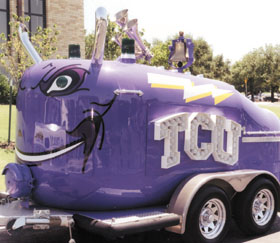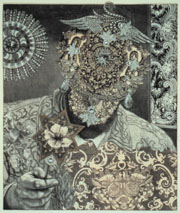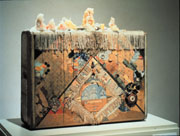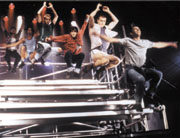By Omar Villafranca staff reporter TCU students skipping classes to attend Mardi Gras might see a familiar sight in one of the night parades. The TCU FrogHorn will be in the "Krewe of Selene: Goddess of the Moon" night parade in Slidell, La., on Wednesday.
"It's great for TCU," Vaughn said. "It's an opportunity to get our word out to millions of people who will see (the parade) in person and on TV." The FrogHorn was a gift from the Burlington Northern Railroad in 1994. Since then, the FrogHorn has been at every TCU football game and other numerous sporting events. Eric Hyman, TCU's athletics director, said he is excited about the idea of the FrogHorn going to the parade to expose others to TCU. "It's a great idea," Hyman said. "What (Vaughn) has done has brought goodwill, and he is constantly putting a positive message out." Tara Ingram Hunter, a 1989 TCU alumna, had the idea of bringing the FrogHorn to the parade. Hunter is chairwoman of the "Krewe of Selene: Goddess of the Moon" parade. She said when she came to this year's Homecoming football game and saw the FrogHorn, she thought it would be a good idea to have the horn in the parade. Hunter said she asked around to find out how she could get the device in the parade. Hunter said convincing the proper people to get permission was not very hard. "(Vaughn) has been wonderful," Hunter said. "TCU has been very cooperative, and Eric Hyman has been wonderful." Hunter said the FrogHorn will be part of a parade that will be more than a mile long and will follow a route that is 4.3 miles in length. Hunter said the "Krewe of Selene: Goddess of the Moon" parade mainly attracts a family-oriented crowd. Hunter said last year's crowd was an estimated 75,000, and she expects more than 100,000 people to attend this year's parade. Hunter said each person in the parade has at least $650 worth of beads to distribute. She said parade participants will throw out about $212,550 worth of beads into the crowd. "I will be throwing purple beads," Vaughn said with a grin.
Omar Villafranca
Bruce Conner's bizarre creations purposefully blur the boundary between the ridiculous and profound in life. Perhaps, it is this indistinctness that left me both intrigued and confused by the artistic pieces in his latest exhibit at the Modern Art Museum of Fort Worth.
Conner also explores the role of the artist by attempting to remove his identity from several works. In the series of surreal paintings called the "Dennis Hopper One Man Show," the artist assumes the name of his actor friend to hide his identity. In another instance, the artist reproduces a paint-by-number kit illustration of Leonardo da Vinci's "The Last Supper" to strip his work of originality. Again, Conner dances around boundaries, refusing to define the role of the artist. In fact, he contradictorily validates his artistic identity by marking otherwise blank pages with thumb and handprints. Conner's physical presence can also be seen in the life-size, shadowy figure in "Sound of Two Hand Angel."Each room of the exhibit offers unusual visuals to stimulate the mind and occasionally prompt the viewer to wonder what on earth Conner was thinking while in the creative process. I thought of Conner's unique genius while examining his inkblot paintings. Resembling Rorschach tests, some of his more recent images appear like strings of elaborate, black insects with dainty antennae and feelers. In his older inkblot visuals of the mid-70s, the black ink crowds the white space, creating a more abstract image. The sheer mystery behind some of Conner's visuals is what is so appealing and provocative about this exhibit. One room features a series of 13 framed, white canvases. Called "Touch/Do Not Touch," this simple presentation shows one plexiglass-covered canvas with the word, "Touch," written, while the remaining 12 uncovered canvases state, "Do Not Touch." Is this display silly or innovative I wondered.
Another group of religious images is the "Christ Series," which oddly combines traditional images of Christ's life with mechanical elements. The most controversial of these paper collages is the "Deus Ex Machina" because it depicts God as the creator of humans that are moving toward dangerous technological advances. In this scene, God's large hand creeps in from the borders of the page to press a start button on Christ's back. At the same time, Christ reaches forward for the button that will set of a nuclear bomb. Of course, this work criticizes humankind's dependence on technology, but the stop button that God's hand does not reach for also carries religious implications. Just when I thought I had seen the strangest artistic creations, I entered the last room of the exhibit, filled with these hanging compilations of apparent junk. At this point, the boundary between the absurd and brilliant was most difficult for me to comprehend. Nonetheless, Conner's work fascinated me to the end, and I couldn't resist turning over the images in my mind as I drove back to campus.
Danielle Daniel
By Alisha Brown skiff staff It takes real men to dress in construction gear and dance, but "Tap Dogs" delivers. The performance by six men from Australia, the United States, England and Canada, has an international reputation for high energy. "Tap Dogs" is being presented by Fort Worth's Casa Mañana Theatre at the Nancy Lee and Perry R. Bass Performance Hall Feb. 29 - March 5 as part of the 1999-2000 "Broadway at the Bass" season. The Indianapolis Star said the program is masculine in nature and appeals to audiences that would not normally attend a dance show. Dancers use all types of construction materials in the 29-segment performance - from chain saws to scaffolding - to present the musical and rhythmic side of an industrial site. The Los Angeles Times wrote, "At one point the dancers become a literal tap-engine: chugging forward silhouetted in billows of smoke." In another segment a dancer is raised on ropes and suspended from the ceiling to deliver an upside-down solo on a metal sheet - a feat most hard-hat wearers most likely would not attempt. In the "Grinder" chain saws send sparks pulsating to the choreography for an in sync feel of man and machine.
Australian choreographer Dein Perry began tapping at age 4 and then at 17 earned his union papers to do industrial work until he could break into show business. Six years later in Sydney he played Andy Lee in "42nd Street" and continued to appear in shows such as "Man of La Mancha," "My Fair Lady" and "Rasputin." Perry desired to bring more contemporary music to the stage and put together this 90-minute dance and musical show that has been performed around the world - from London to L.A. - based on his upbringing in Newcastle, Australia as an industrial mechanic. "Tap Dogs," still wear Blundstone Boots, Australia's authentic work boot - a trend picked up by celebrities such as Cindy Crawford, Helen Hunt and Michael Jackson dancers. Tickets are on sale at TicketMaster at 817-467-ARTS or 214-631-ARTS and at the Casa Mañana Theatre box office or Bass Performance Hall for $24-$59. TCU Programming Council is also selling tickets for $20 to the Feb. 29 performance at their office in Reed Hall. |
| The TCU Daily Skiff © 1998, 1999 Credits |
 Kenny Vaughn, TCU's FrogMan and keeper of the FrogHorn,
will accompany the large purple noisemaker on the trip. Vaughn said he
is excited about taking the FrogHorn and participating in the festivities.
Kenny Vaughn, TCU's FrogMan and keeper of the FrogHorn,
will accompany the large purple noisemaker on the trip. Vaughn said he
is excited about taking the FrogHorn and participating in the festivities. "2000 BC: The Bruce Conner Story Part II" is intended
to introduce us to the wide array of mediums the artist utilized from 1954
to the present to explore spirituality in a technological age. Often, Conner
examines this theme by mixing religious and contemporary images and by
creating abstract prints of heavenly bodies.
"2000 BC: The Bruce Conner Story Part II" is intended
to introduce us to the wide array of mediums the artist utilized from 1954
to the present to explore spirituality in a technological age. Often, Conner
examines this theme by mixing religious and contemporary images and by
creating abstract prints of heavenly bodies. Conner's most visually stunning pieces are
perhaps his collection of photograms of a white silhouette angel against
a black background. Conner has transformed himself into an image of pure
light to represent the spiritual body, bringing to mind the Shroud of Turin,
the burial cloth into which Christ's body has presumably been burned.
Conner's most visually stunning pieces are
perhaps his collection of photograms of a white silhouette angel against
a black background. Conner has transformed himself into an image of pure
light to represent the spiritual body, bringing to mind the Shroud of Turin,
the burial cloth into which Christ's body has presumably been burned. "It's an amazing achievement: celebrating male energy
and muscle power with enough intensity to hook a mass audience and yet
staying thoughtful and pertinent," the Los Angeles Times reported.
"It's an amazing achievement: celebrating male energy
and muscle power with enough intensity to hook a mass audience and yet
staying thoughtful and pertinent," the Los Angeles Times reported.